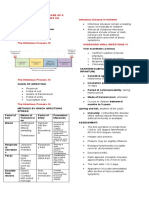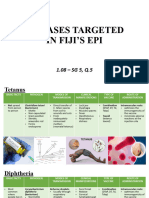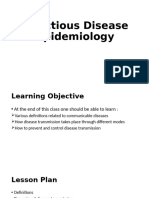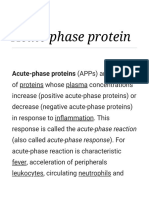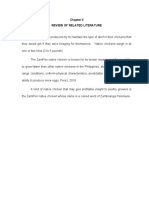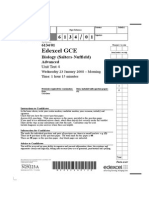Communicable Diseases Notes
Communicable Diseases Notes
Uploaded by
wxyzjaaizahCopyright:
Available Formats
Communicable Diseases Notes
Communicable Diseases Notes
Uploaded by
wxyzjaaizahOriginal Title
Copyright
Available Formats
Share this document
Did you find this document useful?
Is this content inappropriate?
Copyright:
Available Formats
Communicable Diseases Notes
Communicable Diseases Notes
Uploaded by
wxyzjaaizahCopyright:
Available Formats
COMMUNICABLE DISEASES CONCEPT Example No.
2: Typhoid Fever
COMMUNICABLE DISEASE Pathogen
(Causative Agent)
• An illness communicated to man and animals
E.g., Typhoid Fever
TYPES OF COMMUNICABLE DISEASES Susceptible Host
1. INFECTIOUS (E.g., Person-
Reservoir
(E.g., Human)
• The person is only be infected if directly inoculated. Immunosupressed)
2. CONTAGIOUS
• Easily be transmitted from one person to another
• E.g., PTV, Pneumonia (1-3 days incubation period)
CLASSIFICATION OF INFECTIOUS DISEASES Portal of Entry Portal of Exit
BASED ON OCCURRENCE OF DISEASE (E.g., Mouth) (E.g., Anus)
1. PANDEMIC
• Geographical, worldwide
Mode of
• E.g., COVID-19, Spanish Flu, Plague, Smallpox, Ebola Transmission
2. EPIDEMIC (E.g., Feco Oral)
• Diseases that attack the people at a certain area at the
same time.
VACCINATION
• E.g., Monkeypox, Dengue
• Act of injecting the vaccine into the body.
3. SPORADIC
• Happens every now and then
TYPES OF VACCINE
• E.g., Tetanus, Rabies
1. ATTENUATED VACCINE
4. ENDEMIC
• Weakened the virus before they introduce the vaccine
• Seasonal diseases
• E.g., MMR, Varicella
• E.g., Malaria
2. INACTIVATED
5. OUTREAK
• Tinanggalan ng lakas
• If there is one person start to spread the disease.
• E.g., Hepa A, Rabies
3. TOXOID
MODES OF TRANSMISSION
• Tetanus (tinanggalan ng toxin)
1. CONTACT TRANSMISSION
4. SUBUNIT VACCINE
• Direct
• Provoke the immune system, then try to introduce the
• Indirect (Objects) vaccine
• Droplet • E.g., COVID-19 Vaccine
2. VEHICLE
5. CONJUGATE VACCINE
• Food (Hepa A)
• Made using pieces that are chemically done (processed)
• Water (Shigellosis) • E.g., PCV
• Drugs (Bacteria) *Note: Vaccine has no overdose.
• Blood (Hepa B)
3. AIRBORNE TRANSMISSION IMMUNIZATION
• Chickenpox • A process which an anyone’s immune system is
• Measles immunified to produce antibody to fight the pathogens.
• Tuberculosis
4. VECTOR BORNE TAKE HOME EXAM!!! (YELLOWPAD PAPER)
• Malaria 1. Give one example of Communicable Disease, make a Chain
• Dengue of Infection, and on the side put some of the ways of how to
break the chain.
CHAIN OF INFECTION
Pathogen CHAIN OF INFECTION
(Causative Agent) Pathogen (Causative Agent):
E.g., Pneumonia
Reservoir:
o Ways to stop the Chain of Infection:
Susceptible Host
Reservoir Portal of Exit:
(E.g., Person-
Immunosupressed)
(E.g., Human) o Ways to stop the Chain of Infection:
Mode of Transmission:
o Ways to stop the Chain of Infection:
Portal of Entry:
o Ways to stop the Chain of Infection:
Susceptible Host:
Portal of Entry
Portal of Exit o Ways to stop the Chain of Infection:
(E.g., Respiratory
(E.g., Eyes, Nose)
Tract)
2. What is Immunity? Differentiate types of immunity and
examples of each.
Mode of
Transmission • Active Immunity
(E.g., Droplets) o Natural?
o Artificial?
COMMUNICABLE DISEASES CONCEPT (PROF. RAQUEL MACARAMBON, RN, MSN, MAN) 1
• Passive Immunity o By implementing these measures, we can effectively
o Natural? break the chain of infection for influenza and reduce
o Artificial? its transmission within the community.
• Acquired (Adaptive) Immunity *References: Szklo, M., & Nieto, F. J. (2014). Epidemiology:
o Natural? Beyond the Basics. Publisher.
o Artificial? Centers for Disease Control and Prevention. (2023). Influenza
(Flu). Retrieved from:
ANSWER! https://www.cdc.gov/flu/about/keyfacts.htm
1. CHAIN OF INFECTION FOR INFLUENZA World Health Organization. (2023). Influenza (Seasonal).
• PATHOGEN (CAUSATIVE AGENT): The pathogen in this Retrieved from: https://www.who.int/news-room/fact-
case is the influenza virus, which can cause respiratory sheets/detail/influenza-
illness. (seasonal)?gclid=EAIaIQobChMIm9Lmi7KtgQMVWaVmAh06h
• RESERVOIR: The reservoir for the influenza virus gD3EAAYASAAEgIf7fD_BwE
includes infected individuals who can transmit the virus to
others. This can be people with symptomatic or 2. Immunity is the body's intricate and highly coordinated
asymptomatic infections. system for defending against foreign agents or organisms that
Ways to stop the Chain of Infection: may threaten its health and integrity. This defense mechanism
o Vaccinating individuals to reduce the number of allows the body to mount specific protective responses to
potential reservoirs. neutralize and eliminate these invaders. Immune responses
o Isolating individuals with confirmed influenza to can be influenced by various factors such as genetics, cellular
prevent further transmission. interactions, and external factors like medications, diet, and
o Promoting respiratory hygiene and cough etiquette in stress. Dysfunctions in the immune system can lead to a wide
infected individuals. range of health issues. Immune memory enables the immune
• PORTAL OF EXIT: The primary portal of exit for the system to remember and respond effectively to previously
influenza virus is respiratory secretions, such as saliva encountered harmful agents, while tolerance ensures that the
and mucus, when an infected person coughs or sneezes. immune system can distinguish between self-antigens and
Ways to stop the Chain of Infection: foreign substances.
o Encouraging infected individuals to cover their mouth • A. Active Immunity- Active immunity is a type of acquired
and nose when coughing or sneezing. (adaptive) immunity that develops within an individual's
o Providing tissues and proper disposal methods for own body as a result of exposure to antigens, either
used tissues. through infection or immunization.
• MODE OF TRANSMISSION: Influenza is primarily o Natural Active Immunity: This occurs when an
transmitted through respiratory droplets when an infected individual's immune system responds to and develops
person coughs, sneezes, or talks. It can also spread immunity after being exposed to a disease-causing
through direct contact with contaminated surfaces and pathogen. For example, when a person contracts
subsequent hand-to-face contact. chickenpox and subsequently becomes immune to
Ways to stop the Chain of Infection: future chickenpox infections.
o Practicing good hand hygiene by washing hands o Artificial Active Immunity: This type of immunity is
frequently with soap and water. induced through vaccination or immunization.
o Using alcohol-based hand sanitizers when soap and Vaccines contain weakened or inactivated forms of
water are not available. pathogens, stimulating the immune system to produce
o Regularly cleaning and disinfecting frequently- a protective response. An example is receiving a flu
touched surfaces, especially in public places. shot to prevent influenza.
o Wearing masks in crowded or healthcare settings to • B. Passive Immunity- Passive immunity is characterized
prevent respiratory droplet transmission. by the temporary acquisition of immunity through the
• PORTAL OF ENTRY: The influenza virus can enter a transfer of antibodies or immune components from
susceptible host through the mouth, nose, or eyes when another source, rather than the individual's own immune
they come into contact with respiratory droplets or response.
contaminated surfaces. o Natural Passive Immunity: This occurs when a
Ways to stop the Chain of Infection: mother passes antibodies to her baby either in utero
o Educating individuals to avoid touching their face, (during pregnancy) or through breast milk. These
especially their eyes, nose, and mouth. maternal antibodies provide the infant with temporary
o Using personal protective equipment (PPE) like protection against various diseases.
masks and eye protection in healthcare settings. o Artificial Passive Immunity: Involves the
o Encouraging good respiratory hygiene in the administration of pre-formed antibodies or immune
community to reduce the release of infectious globulins obtained from another individual or a
droplets. laboratory source. An example is the administration of
• SUSCEPTIBLE HOST: A susceptible host can be anyone antibodies against a specific pathogen, such as rabies
who has not developed immunity to the specific strain of immune globulin, following exposure to the rabies
influenza in circulation. This includes individuals with virus.
weakened immune systems, the elderly, and those who • C. Acquired (Adaptive) Immunity: Acquired immunity,
have not been vaccinated. also known as adaptive immunity, develops after exposure
Ways to stop the Chain of Infection: to antigens and involves a specific and tailored immune
o Promoting influenza vaccination among all eligible response.
individuals. o Natural Acquired Immunity: Occurs when an
o Isolating and providing appropriate medical care for individual's immune system responds to and develops
infected individuals to reduce their susceptibility. immunity after encountering a disease-causing
o Encouraging individuals to maintain good overall pathogen. For example, someone who recovers from
health through proper nutrition and rest.
COMMUNICABLE DISEASES CONCEPT (PROF. RAQUEL MACARAMBON, RN, MSN, MAN) 2
a streptococcal infection develops immunity to that TETANUS (LOCKJAW)
specific strain of bacteria. • Also called as “lockjaw- occurs in the presence of toxins”
o Artificial Acquired Immunity: This type of immunity • It is an infectious disease cause by Clostridium tetani
is intentionally induced through medical interventions. (Sources: found in soil, fecal matter)
It includes both active and passive artificial immunity. o It is anaerobic (means it cannot survive with the
Active artificial immunity is achieved through presence of oxygen).
vaccination, as explained earlier. Passive artificial o It is coated, means can survive in the presence of air
immunity involves the direct transfer of antibodies or but cannot multiply.
immune components to provide immediate protection, o It can survive about 40 years.
such as receiving antivenom after a snakebite. o If it enters to a specific location in the body, where
*In summary, immunity encompasses the body's defense there is no presence of air, the coating will disappear
mechanisms against foreign invaders, with active and starts to multiply.
immunity arising from an individual's own immune • Incubation Period: Average of 10 days
response and passive immunity being the temporary
acquisition of immunity through external sources. Acquired MODE OF TRANSMISSION
(adaptive) immunity can result from natural exposure to
• Traumatic wound
pathogens or deliberate interventions like vaccination,
• Burns
contributing to long-term protection against specific
diseases. • Lacerations
*References: Cheever, K., Hinkle, J., (2018). Brunner & • Scratches (open wound, tooth decay- susceptible in the
Suddarth’s Textbook of Medical-Surgical Nursing (14th presence of bacteria because tinutusok ng walis tingting)
Edition). Two Commerce Square, 2001 Market Street, • Septic abortion
Philadelphia, PA 19103. Lippincott Williams & Wilkins. • Uncleaned dressing
• Compound fracture
IMMUNITY • Infected umbilical cord stumps (unsterile labor)
• Developed during life • Circumcision
• Immunized and produce antibody during birth. • Ear piercing
Natural
(The baby's ability to SIGNS AND SYMPTOMS
Active Immunity produce antibody) CHILDREN
(Protection from
Birth) • Fever (24 hrs. of fever is a good mechanism of the body
Artificial especially during vaccine administration), maybe given
(Vaccination) antipyretic or antibiotic drugs as prescribed by the doctor.
Immunity • Excessive crying (3-10 days onset), cannot breastfeed
• Attempts to suck, results to spasm
Natural
(Breastfeeding) • Jaw stiffness causses spasm
Passive Immunity • Stimulant sensitive (noise, attempting to touch)
(Protection from
another organism) • Hoarse Cry (Dysphonia)
Artificial • Cyanosis that can cause death
(Immunization)
ADULTS
• Muscular spasm (24-48hrs the stiffness increases)
TAKE HOME QUIZ • Trismus (stiffness of jaw- lock jaw)
Give the differences of IgG, IgA, IgM, IgD, IgE, and site 3 • Opisthotonus (spasm of the muscles causing backward
examples each. arching of the head, neck, and spine)
• Foot drop (inability to lift the forefoot due to the weakness
of dorsiflexors of the foot)
• Sardonic smile (ngiting aso)
• Spasms in the extremities that can cause deathn
COMPLICATIONS
• Hypostatic pneumonia (chronic pulmonary disorder)
• Congestion
• Blood stasis
• Edema (due to bed ridden for a longer period of time)
• Hypoxia- deficiency in blood oxygen
• Atelectasis- collapse of the lungs
• Fracture
TREATMENT
• Proper wound care (soap and running water)
• Within 24hrs, the patient must be given:
o Tetanus Toxoid (0.5 mL) IM, no skin test
Td, Tdap, DT, DPT, DTaP, or tetanus toxoid,
depending on age or allergies
COMMUNICABLE DISEASES CONCEPT (PROF. RAQUEL MACARAMBON, RN, MSN, MAN) 3
o Anti-Tetanus Serum (ATS) IM, ANST- 4,500 IU; CINICAL MANIFESTATIONS
o Tetanus immune globulin (TIg) (0.5 mL) IM, no skin (3 CLINICAL PHASES OF RABIES)
test (if reacted to ATS) • PRODROMAL PHASE (STAGE OF INFECTION)
• Patient may be given: o Fever
o Metronidazole, and Penicillin G Sodium as o Anorexia
prescribed. o Sore throat
o Erythromycin and Tetracycline as prescribed. o Excessive crying
o Diazepam (for muscle spasm) as prescribed. o Hyperexcitability
• Patient may be given NGT (or inserting tracheostomy tube o Mental depression
if hindi makahinga yung patient, maintaining Fluid and o Marked insomnia
Electrolytes) o Pain in the bitten site
o Tingling sensations
VACCINATION OF TETANUS TOXOID
TYPE OF TT PROTECTION FOLLOWED-UP • PATHOGNOMONIC SIGNS (STAGE OF EXCITEMENT
TT1 30 Days - OR EXCITATION PHASE)
TT2 1-3 Years After 1 month o Hydrophobia- The mere sight of water
TT3 5 Years After 6 months o Aerophobia- Having air blown in the face
TT4 10 Years After a year o Photophobia- Abnormal intolerance to light
TT5 Lifetime After 3 years
• PARALYTIC/PARALYSIS OR TERMINAL PHASE
RABIES (HYDROPHOBIA, LYSSA) o Patient becomes silent (Taking cocktail meds to
• Severe viral infection communicated through bites in sleep)
infected animals (dogs, cats, horse, cattle, monkey, o Patient is dying
racoon) o Pathognomonic signs
o Prone in puppy (because of cuddling), even the o Patient undergoes RT-PCR (Reverse Transcriptase
slightest scratch can cause rabies (How to know: Put Polymerase Chain Reaction)- detection of rabies in
an alcohol of the site, if mahapdi, then meron kang saliva and skin biopsy (pugutan ng ulo tapos I
scratch). examine ang brain if (+) or (-) ba sya sa rabies.
• Causative Agent: Lyssavirus (neurotropic virus from
Greek word Lyssa, the goddess of rage, fury, and rabies -- PREVENTIVE MEASURES
- frenzy or madness) or the Rhabdovirus • Health education/Health teaching
• Incubation Period: 6 months • Proper wound care (wash using soap and running water),
o 10 days to 3 months after you get the virus, lalabas air dry, advise to go to the nearest health center.
ang signs and symptoms.
• Hydrophobia (fear of water) TYPES OF ANTI-RABIES VACCINE (ARV)
• 1. PURIFIED VERO CELL RABIES VACCINE (PVRV)
MODE OF TRANSMISSION o 0.5 mL (Php 1,200 per vial), 5 doses (The first dose is
• Close contact with infected saliva. injected in left arm then the rest is in the right arm),
o Gaano katagal mag observed sa aso na IM.
nangangagat? o Schedule: Days 1, 3, 7, 14, and 30 (Within a month)
7 days to 7 months • 2. PURIFIED CHICK EMBRYO CELL VACCINE (PCEV)
2 weeks to 4 months o 1mL(Php 900 per vial), Deep IM (Puwet), ANST
o Bakit nagkaka-rabies ang aso na nasa bahay lang • 3. ERIG (Equine Immunoglobulin) VACCINE
sya? o Produced in horses (plasma)
Gumagala kasi yung pusa, kapag nagka close o 5cc (Php 2,500 per vial)
contact sya ng infected animal, nagkakaroon ng o Equation of ERIG Vaccine dosage
tranmission tapos may tendency din na iisa lang (𝐵𝐵𝐵𝐵𝐵𝐵𝐵𝐵 𝑤𝑤𝑤𝑤𝑤𝑤𝑤𝑤ℎ𝑡𝑡)𝑥𝑥 (0.2) = 𝑚𝑚𝑚𝑚 𝑜𝑜𝑜𝑜 𝑣𝑣𝑣𝑣𝑣𝑣𝑣𝑣𝑣𝑣𝑣𝑣𝑣𝑣
yung pagkainan nila sa aso, kaya yung aso *20 (IU) international units= 0.2ml per kg of body
magkaka rabies din. weight
Scratch wound from cats can also cause infection
since cats usually lick their paws.
PATHOPHYSIOLOGY
• The virus can go to skin, to nerves, to CNS, or sumasama
sa saliva to nerve (E.g., nananamlay, kahit anong ipakain
nagiging violente ~maniacal, behavior drooling, (+) rabies
(the dog should be talied)
• Diagnostic Test: FRAT (Fluorescence Antibody
Technique)- looks for antigen for brain injury.
COMMUNICABLE DISEASES CONCEPT (PROF. RAQUEL MACARAMBON, RN, MSN, MAN) 4
DENGUE (BREAKBONE FEVER) PREVENTION (4S)
• Mosquito-borne illness in tropical areas • Self-protectives clothing (E.g., long sleeves, long pants)
• Cause from bite of Aedes mosquito • Say no to (indiscriminate) left and right defogging
• Incubation Period: 4-6 days, maximum of 10 days o Stay hydrated
• Causative Agent: Dengue virus (Flaviviridae) • Seek early consultation
• Seek and Destroy breeding place
OTHER NAMES OF DENGUE
o Breakbone fever NURSING MANAGEMENT
o Dandy fever • Isolation
o Infectious thrombosis • Control of hemorrhages
o Hemorrhagic fever • Close observation of patient
VECTOR CAUSES DENGUE MALARIA (AGUE)
• Aedes Aegypti • Serious/fatal disease
• Aedes Albopictus • Caused by parasites
• Aedes Polynesiensis • Type of mosquito: Female Anopheles Mosquito
• Aedes Scutellaris • Incubation Period: Plasmodium Falciparum- 12 days,
Plasmodium Vivax and Plasmodium Ovale- 14 days, and
MODE OF TRANSMISSION Plasmodium Malariae- 30 days.
• Bite of infected mosquito • Mother to child transfer- Neonatal Malaria
o 6:00 am before sunrise
o 4:00 pm before sunset CAUSATIVE AGENT (VECTORS)
• Plasmodium Falciparum (Common)
SIGNS AND SYMPTOMS • Plasmodium Vivax
• Onset of fever (2-7 days) • Plasmodium Ovale
• Body weakness • Plasmodium Malariae
• Skin rashes
• Spontaneous disease SIGNS AND SYMPTOMS
• Melena Stool- black, tarry stool that comes from bleeding • Chills
in the gastrointestinal (GI) tract. • High grade fever
• Vomiting
PATHOGNOMONIC SIGNS
• HERMAN’S SIGN- lower to upper discoloration (dalmatian RISK FACTOR
white dots) • History of travel with no infection of malaria
o Reddish rash that makes the affected area more red
than fresh-colored. DIAGNOSTIC TEST
• Malarial smear or peripheral blood smear
CLINICAL MANIFESTATIONS
• In the 1st day (Invasive Stage)- patient experiences fever, PREVENTIVE MEASURES
nausea and vomiting, liver damage • Eliminate the sources of mosquito
• In the 3rd day (Hemorrhagic Stage) color pink palm and • Do activities in daytime
foots • Don’t go to places having vast cases of malaria
• In the 7th day (Convalescent Stage)- HERMAN’S Signs, • Medications:
severe pruritus o Chloroquine (drug of choice)
o Primaquine
CLASSES ACCORDING TO SEVERITY o Quinine (used in Plasmodium Falciparum as a cause)
• GRADE I: fever, nonspecific institutional symptoms, o Antibiotics: Doxycycline, Tetracycline
positive torniquet test • Blood transfusion
• GRADE II: hemorrhagic fever, spontaneous fever, GI
bleeding, dengue hemorrhagic fever NURSING MANAGEMENT
• GRADE III: circulatory failure, decrease blood pressure, • Isolation
patient experienced restlessness, dengue shock fever • Use mosquito nets
• GRADE IV: profound shock, undetectable blood pressure • Insecticides
• Care of exposed patients
DIAGNOSTIC TEST • Supportive persons (supporting system)
• Torniquet test- CBC with platelet count of 120 up
(CONFIRMATORY TEST)
TREATMENT
• Fever- administer antipyretic drugs as prescribed
• Increase fluid intake
o IV: 0.9% NaCl, PLR
COMMUNICABLE DISEASES CONCEPT (PROF. RAQUEL MACARAMBON, RN, MSN, MAN) 5
LEPTOSPIROSIS (WEIL’S DISEASE, CANICOLA FILARIASIS
FEVER, MUD FEVER, SWINEHERD’S DISEASE) • A disease cause by chronic mosquito- parasitic infection
• Bacterial infection transmitted by many animals such as • No vaccine yet
rodents (E.g., rats and mice) through urine, fecal material • As it progresses, it can cause thickening of the muscles
na nilalabas ng rats (nakukuha sa contaminated food and (ang mga pasyente ay lumalaki at bumibigat) called
water [ingestion]). “ELEPHANTIASIS”
• If bitten by rat, you will be infected by tetanus (clostridium • Transmitted by 5 Genera of Mosquito: Aedes,
tetani) because of open wound (if hindi ka nag slippers). Anopheles, Culex, Mansonia, and Oclerotatus.
• Incubation Period: 10 to 12 months
ETIOLOGY • It takes repeated bites before you got infected.
• Leptospira ictero-haemorrhagiae carried by wild rat
• Leptospira Canicola THREE SPECIES OF HEMATO PARASITES:
• Leptospira Bataviae o Wuchereria bancrofti
• Leptospira Pomona o Brugia malayi
• Leptospira Grippotyphosa o Brugia Timora
• Leptospira Javanica
• Leptospira Pyrogenes NURSING DIAGNOSIS
• Leptospira Manilae • Immobility
• Disturbed Body Image
MODE OF TRANSMISSION
• Ingestion DIAGNOSTIC TEST
• Blood test (peripheral blood smear) – obtain at night bet.
SIMPLIFIED SIGNS AND SYMPTOMS 10pm to 2pm
IN SOME CASES • PCR (polymerase chain reaction) – detects the presence
of antigen
• Fever
• Scrotal Ultrasound
• Muscle Pain
• Reddish Eyes (in some cases)
MEDICAL TREATMENT
SEVERE CASES • Patient maybe given Diethylcarbamazine citrate which is a
micro filaricidal
• Neuro involvement • Ivermectin (used in COVID patients)
• Kidney Failure • Mebendazole
• Brain Involvement • Doxycycline
TREATMENT SURGICAL TREATMENT
• Antibiotic Drug of Choice • Debugging of Skin (Nililiitan)
o Pengisodium/Tetracycline
SIGNS AND SYMPTOMS
CLINICAL MANIFESTATIONS • Fever
1. SYPTESEMIC STAGE (LASTED 4-7 DAYS) • Inguinal Pain or Vestibular Pain
• Febrile • Skin Exfoliation
• Chills • Lymph and Genital Swelling
• Headache
• Anorexia PREVENTIVE MEASURES
• Nausea and Vomiting • Eradication of Mosquito
• Abdominal Pain • Wear long clothes (long sleeves and pants)
• Muscle Pain (Severe) • Avoid being in area that have infestations
• Use mosquito repellant to avoid mosquito bites
2. IMMUNE/TOXIC STAGE (LASTED TO 4-13 DAYS)
• With/without jaundice
NURSING MANAGEMENT
• Death may occur in severe cases (9th to 16th day)
• Prevent potential complications
3. CONVALESCENCE STAGE (4TH TO 5TH WEEK) • Application of Elastic Bandages or stockings to affected
limb
• Bed rest
DIAGNOSTIC PROCEDURE
• Elevation of involved extremities
• History of Patient
• Culture (Spirochaete in the Blood, Urine and Cerebral-
Spinal Fluid)
NURSING MANAGEMENT
• Isolate the patient
• Advise proper disposal of urine
• Advise family members to clean dirty steres
• Eradicate rats
• Avoid bathing in contaminated water.
COMMUNICABLE DISEASES CONCEPT (PROF. RAQUEL MACARAMBON, RN, MSN, MAN) 6
STI (SEXUALLY TRANSMITTED INFECTIONS) SYPHILIS (LUES VENEREAL, MORBUS GALLICUS)
• Also known as STD (Sexually-Transmitted Diseases) • Bacterial infection usually spread by sexual contact
• Usually infects male persons (multiple sexual partners typically on genital, rectum, and mouth (cold sore does not
most of the time) necessarily means Syphilis).
• It spreads through sexual intercourse • Caused by: Treponema pallidum
• No vaccine has been developed.
TYPES OF STI • A disease starts genital sores at a “PAINLESS FORM”
o Most common: • Spreads person-to-person via skin or mucous
1. SYPHILIS (Treponema pallidum) membrane, contact with sores
2. GONORRHEA (Neisseria gonorrhoeae) • Without the treatment, it can severely damage the heart,
3. HIV brain, and other organs that can be life-threatening.
Most cases ang ikinamamatay ay • Incubation Period: 10-90 days, average of 21 days
Pneumonia • Period of Communicability: Up to 5 years if nahawa
Caused by “CORONA VIRUS” through sexual intercourse, but at peak (maximum na
o Others: nakakahawa sya) is in 2ND YEAR. In congenital
1. CHLAMYDIA (Chlamydia trachomatis) transmission, it is throughout the PERIOD OF
2. GRANULOMA INGUINALE or Donovanosis PREGNANCY.
(Klebsiella granulomatis or Calymmatobacterium
granulomatis) SIGNS AND SYMPTOMS
3. GENITAL HERPES
PRIMARY SYPHILIS
4. HERPES INDEX VIRUS TYPE II
5. HUMAN PAPILLOMA VIRUS (HPV) causing • Chancre- painless sore at the genital area (usually
Genital Warts and Cervical Cancer (Women) develops about 3 weeks after exposure) which it heals on
6. HEPATITIS B (though blood transmission and its own 3-6 weeks.
sexual intercourse) causing liver cancer (if long-
term Hepa B) SECONDARY SYPHILIS
7. VAGINAL TRICHOMONIASIS- Vaginal infection • Within few weeks after the chancre was healed, rash
or yeast/ vulvovaginitis begins to appear in the trunk, eventually covers the entire
body, even in the palms and soles of the feet. The rash is
usually not itching, maybe accompanied by mouthlike
WHY IT INCREASES THE PREVALENCE OF STI? sores in the mouth and genitals.
• Because of EARLY BEHAVIORAL MATURITY • Some people experience hair loss, muscle aches, fever,
(male/females early exposed because of curiosity, sore throats, and swollen lymph.
pornography)
• Use of Alcohol and Drugs (Nawawala na sa sarili, nagiging LATENT SYPHILIS
malakas ang loob, at hindi na makapigil or nawawala ang • No clinical symptoms
inhibition pagdating sa sex)
• Marami contraceptives (condom- most common) TERTIARY SYPHILIS
o Use 2 condoms (baka butas yung isa, makakabuntis)
About 15- 30% of people infected with syphilis do not develop
• Male homosexuality
complication, but in long term, it damages the:
• More travel opportunity (seaman)
• Brain
• Those who practices multiple partners
• Nerves
• Eyes
MODE OF TRANSMISSION • Heart
• Sexual intercourse
• Blood vessels
• Mother to child (NSVD)
• Liver
• Bones
SIGNS AND SYMPTOMS • Joints
• Fever
• Soreness
MODE OF TRANSMISSION
• Unusual lumps and sores
DIRECT CONTACT
• Itching
• Pain when urinating • Sexual intercourse
• Unusual discharge of genitals • Usually transferred through kissing (mouth sores)
• Dental or other surgical or technical accidents
TREATMENT
• Topical creams for Female (Vulvitis- itchy inflammation of INDIRECT CONTACT
vulva) and Male (Balanoposthitis- the head of the • Contact with discharges na sumama sa gamit ng pasyente
penis/gland become inflamed)
• Antibiotics for chlamydia, gonorrhea, and syphilis. RISK FACTORS
• Antiviral for Herpes and HIV. • Engaged in unprotected sex (no condoms)
• Lotions and Liquid Nitrogen (for warts freezing) for Human • Multiple partners
Papilloma Virus. • Man having sex with men that are infected with HIV
• Oral Medications for Hepa B.
• Antiparasitic and Antibiotic for Vaginal Trichomoniasis. DRUG OF CHOICE
• Penicillin
COMMUNICABLE DISEASES CONCEPT (PROF. RAQUEL MACARAMBON, RN, MSN, MAN) 7
PREVENTIVE MEASURES HIV-AIDS
• Abstain • It is an infection that attacks the body’s immune system
• Be monogamous (AIDS). As the HIV progresses, it will become AIDS.
• Use condoms and avoid recreational drugs • Chronic disease
GONORRHEA (GONO CLAP, GLEET) CAN BE ACQUIRE AND SPREAD THROUGH:
• It is an infection involving mucosal of the GUT, rectum, 1. Sexual Contact
and the pharynx. 2. Blood Transfusion
• Incubation Period: 2 to 5 days, up to 7 days 3. Drug users uses single needle only
• It affects the Genital Tract
IS AIDS LIFE-THREATENING?
AT RISK • No. The complications make it life-threatening because it
• Having sex with unknown person with unknown suppresses the immune system.
background (one-night stand)
• Having new sex partner na hindi mo kakilala (nauubusan AT RISK
ng sex partner, may ka sex partner na iba, nakikipag sex • 65% Homosexual (gay) or Bisexual (both gender)
sa ka sex partner na nakipag sex sa iba) • 8% Homosexual and Bisexual who are iv drug users
• Having more than one sex partner/multiple partners • 17% Heterosexual who are iv drug users
• 2.4% Hemophilia (problems in blood clotting) because
MODE OF TRANSMISSION they constantly receive blood transfusion.
• Sexual Intercourse • 1% female heterosexual (multiple sex with men and
• Direct contamination of mother’s vaginal secretions, as the unknown men)
baby comes out of birth canal.
• Occasionally through fomites MODE OF TRANSMISSION
• Sexual intercourse
SIGNS AND SYMPTOMS • Mother to child
MEN
• Painful urination DIAGNOSTIC PROCEDURE
• Pus like discharges from the tip of the penis • There is no single diagnostic test for AIDS.
• Pain and swelling in one or two testicles (infertility) • ELISA (Enzyme-Linked Immunosorbent Assay)- a test
that checks only the presence of antibodies against HTLV
FEMALE (Human T-Lymphocyte Virus) 3. If it is detected, it
means that the patient is exposed.
• Burning sensation
• Difficulty urinating
SIGNS AND SYMPTOMS
• Increase vaginal discharges
EARLY SYMPTOMATIC INFECTION
• Abdominal and Pelvic Pain
• Fever
COMPLICATIONS • Fatigue
• Hindi magkakaanak • Swollen Lymph Nodes
• Pelvic infection in Women • Diarrhea
• Post-Pneumococcal Urethritis • Weight Loss
• Cough
PREVENTIVE MEASURE • Shortness of Breath
• Practice monogamous
• Use condoms when having sex PRIMARY INFECTION
• Abstain if you can • Flu-like illness occurs after 3 to 6 weeks after acquiring
infection
• Fever
• Muscle soreness
• Rash
• Headache
• Sore throat
• Mouth and genital ulcers
• Swollen lymph glands
• Joint pain
• Night Sweats
• Diarrhea
TREATMENT
• There is no treatment to cure AIDS. It is directed to the
complications, not to the AIDS itself.
• Only drugs are given to inhibit the action of HTLV 3, but
that doesn’t mean that it can lead to clinical improvement.
COMMUNICABLE DISEASES CONCEPT (PROF. RAQUEL MACARAMBON, RN, MSN, MAN) 8
RARE DISEASES
• Pneumocystic Carinni Pneumonia (PCP)
• Kaposi Sarcoma- cancer found in skin or mucous
membranes that are line the gastrointestinal (GI) tract.
o How to know if the patient having this disease? If
patient having blue-violet or brownish spot. If the
spot persists, it may grow large. It appears to the
different parts of the body. There is a presence of
puss in spots and ulceration.
SIGNS AND SYMPTOMS
EARLY STAGE
• Flu-like symptoms
LATE SYMPTOMS
• Extreme tiredness
• Headache
• Dizziness
• Light headedness
• Continued fever
• Night Sweats
• Weight loss of more than 10 pounds without dieting/taking
weight-loss pill
• Swollen glands in the armpit and groin
• Purple/Discolored growth of the skin/mucous membrane
(mouth, anus, and anal passages)
• Continuous bowels with diarrhea
• Thrush- a yeast whitish-coating on the tongue or in the
throat which are accompanied by sore throat.
• Unexplained bleeding from different body opening.
• Progressive shortness of breath.
PREVENTIVE MEASURES
• All sexually male and female should refrain having sex to
unknown person with unknown background.
• Avoid multiple partners
• No sharing of needles
READ!!!
Communicable Diseases affecting the GI Tract.
• Typhoid Fever
• Hepatitis A
• Acute Gastroenteritis
• Amoebiasis
COMMUNICABLE DISEASES CONCEPT (PROF. RAQUEL MACARAMBON, RN, MSN, MAN) 9
You might also like
- Chapter 43: Nursing Care of A Family When A Child Has An Infectious Disorder The Infectious Process #1 Infectious Disease in ChildrenDocument20 pagesChapter 43: Nursing Care of A Family When A Child Has An Infectious Disorder The Infectious Process #1 Infectious Disease in ChildrenMark oliver Gonzales100% (1)
- Guillain Barre Syndrome Case Presentation by Sec-Nursing 3/B Sinco MarkDocument84 pagesGuillain Barre Syndrome Case Presentation by Sec-Nursing 3/B Sinco Markmikkanz75% (8)
- Communicable Disease Maam Jaidee Rojas May 2024 FHODocument24 pagesCommunicable Disease Maam Jaidee Rojas May 2024 FHO9nztbprpc7No ratings yet
- mon-thursDocument1 pagemon-thurssamratsingh.ss2007No ratings yet
- Fiji's EpiDocument13 pagesFiji's Epipofegeg809No ratings yet
- Communicable Diseases 1Document11 pagesCommunicable Diseases 1Glaiza Mae GamatanNo ratings yet
- Microbial InfectionsDocument3 pagesMicrobial Infectionsstanely448No ratings yet
- Communicable DiseasesDocument16 pagesCommunicable Diseasesjianne100% (3)
- CD-2 NotesDocument8 pagesCD-2 NotesRika MaeNo ratings yet
- Communicable Disease Day 1Document7 pagesCommunicable Disease Day 1JolensNo ratings yet
- Infectious Disease EpidemiologyDocument49 pagesInfectious Disease Epidemiologysararai617No ratings yet
- infectious cycleDocument26 pagesinfectious cycleskh00No ratings yet
- Communicable DiseasesDocument7 pagesCommunicable DiseasesKevin KobeNo ratings yet
- Lesson 11 PathogenesisDocument10 pagesLesson 11 PathogenesisJoaqin CastroNo ratings yet
- COMMUNICABLE-DISEASE-NURSING-ONLINE-LECTURESDocument26 pagesCOMMUNICABLE-DISEASE-NURSING-ONLINE-LECTURESJessie Mae TekinerNo ratings yet
- Hdp301infectionrevisedoct2020 1Document24 pagesHdp301infectionrevisedoct2020 1Linda NguyenNo ratings yet
- Introduction To ImmunologyDocument3 pagesIntroduction To ImmunologyRJR SelausoNo ratings yet
- CHN Presentaion-1Document23 pagesCHN Presentaion-1Sada AlakNo ratings yet
- Eca - Communicable Disease NursingDocument14 pagesEca - Communicable Disease NursingFrancis Alfred EscaranNo ratings yet
- Communicable Diseases 2.4-5.22Document9 pagesCommunicable Diseases 2.4-5.22Vhince PiscoNo ratings yet
- Microbiology and ParasitologyDocument59 pagesMicrobiology and ParasitologyJade BuriNo ratings yet
- Immuno Sero Lec Prelim TransDocument15 pagesImmuno Sero Lec Prelim TransLoren EscotoNo ratings yet
- MC3 Lec 4 Basic Concepts of Communicable DiseaseDocument5 pagesMC3 Lec 4 Basic Concepts of Communicable DiseaseCrishaGarraNo ratings yet
- Human HelthDocument6 pagesHuman HelthTK TamilaNo ratings yet
- PMLS FinalsDocument20 pagesPMLS FinalsPhilipp LibasoraNo ratings yet
- Mind Map Human Health and Disease Final PYQs and Exemplar 1Document186 pagesMind Map Human Health and Disease Final PYQs and Exemplar 1Mohit Devraj ParasharNo ratings yet
- Parasitology Note 1Document9 pagesParasitology Note 1UNKNOWN ANGELNo ratings yet
- Micropara Chap 4Document4 pagesMicropara Chap 4John Paul MolinaNo ratings yet
- Cause Agent Type of Agent MOT Signs and Symptoms Prevention and Control Treatment TuberculosisDocument6 pagesCause Agent Type of Agent MOT Signs and Symptoms Prevention and Control Treatment Tuberculosisvanessa patayonNo ratings yet
- Presented By: Henna Dhir Roll No.: RP7005A01 Regd No.: 11002446Document31 pagesPresented By: Henna Dhir Roll No.: RP7005A01 Regd No.: 11002446hennadhir2No ratings yet
- Source, Entry and Body Reaction To Infection 5Document29 pagesSource, Entry and Body Reaction To Infection 5Maxwell C Jay KafwaniNo ratings yet
- Human Health and DiseaseDocument6 pagesHuman Health and DiseaseRisshu Farms100% (3)
- Communicable DiseasesDocument26 pagesCommunicable DiseasesAnnie Rose Dorothy MamingNo ratings yet
- Communicable DiseasesDocument17 pagesCommunicable DiseasesKriska NoelleNo ratings yet
- COMMUNICABLE-DISEASE-NURSING-DAY1.pdf - PDF ExpertDocument24 pagesCOMMUNICABLE-DISEASE-NURSING-DAY1.pdf - PDF ExpertFrances Sofia DuranNo ratings yet
- ANTI-INFECTIVESDocument20 pagesANTI-INFECTIVESchinalmazan0No ratings yet
- Intro ParasitologyDocument4 pagesIntro ParasitologyKaoriMarieSembranoNo ratings yet
- Micropara Lecture Finals ReviewerDocument26 pagesMicropara Lecture Finals ReviewerAngela JelaaNo ratings yet
- 1 Intro To ISDocument2 pages1 Intro To ISanonymousNo ratings yet
- IMMUNOLOGY Student Ver 2024Document17 pagesIMMUNOLOGY Student Ver 2024Sogan, MaureenNo ratings yet
- 6.-Virology 2Document10 pages6.-Virology 2XYPHER JADE GREGORIONo ratings yet
- 5,6 InfluenzaDocument81 pages5,6 InfluenzaHarry DouglasNo ratings yet
- Epidemiology, EpidemicDocument62 pagesEpidemiology, Epidemicanilshah09777No ratings yet
- Dr. Dalia El-Shafei: Assistant Professor, Community Medicine Department, Zagazig UniversityDocument76 pagesDr. Dalia El-Shafei: Assistant Professor, Community Medicine Department, Zagazig Universityabdirahman ibrahim kadiyeNo ratings yet
- Week 5 Bacteria and DiseasesDocument76 pagesWeek 5 Bacteria and DiseasesNorhaifa Hadji EbrahimNo ratings yet
- MICROPARASITOLOGYDocument29 pagesMICROPARASITOLOGYMurfiy ChanNo ratings yet
- PNEUMONIADocument8 pagesPNEUMONIALankeshwaraNo ratings yet
- Communicable DiseasesDocument16 pagesCommunicable Diseasespespes20111No ratings yet
- Disease Detectives Cheat SheetDocument2 pagesDisease Detectives Cheat SheetBereket LakiNo ratings yet
- Communicable Disease: Mr. Pankaj Kusum Ramdas KhuspeDocument113 pagesCommunicable Disease: Mr. Pankaj Kusum Ramdas KhuspeManisa ParidaNo ratings yet
- Chain of InfectionDocument28 pagesChain of InfectionSaadNo ratings yet
- Epidemiology of Infectious DiseasesDocument40 pagesEpidemiology of Infectious DiseasesScribdTranslations100% (1)
- Dynamics of Disease Transmission: Dr. Adeel Ahmed KhanDocument55 pagesDynamics of Disease Transmission: Dr. Adeel Ahmed KhanAparna Kingini100% (1)
- Manangement of Patients With Infectious Disease Intended Learning OutcomesDocument10 pagesManangement of Patients With Infectious Disease Intended Learning OutcomesJoevence Gazo CuaresmaNo ratings yet
- COMMUNICABLEDocument18 pagesCOMMUNICABLEDarren VargasNo ratings yet
- Communicable DiseasesDocument32 pagesCommunicable DiseasesAveryl CalumnagNo ratings yet
- COMMUNICABLEDocument22 pagesCOMMUNICABLEMaren Lyle CoNo ratings yet
- MicroPara 1Document6 pagesMicroPara 1Ara PanganibanNo ratings yet
- Communicable DiseaseDocument5 pagesCommunicable DiseaseLordson Gem P. IbonNo ratings yet
- 2023.pedia - Trans26.BacteriaI-Infections-Gram Negative (Part3)Document14 pages2023.pedia - Trans26.BacteriaI-Infections-Gram Negative (Part3)Adrian CaballesNo ratings yet
- 3 Wood Flow HematopoieticDocument24 pages3 Wood Flow Hematopoieticalper togayNo ratings yet
- Relationship Between Nutrition and ImmunityDocument3 pagesRelationship Between Nutrition and Immunityrhib47957No ratings yet
- PARASITIC NEMATODES Molecular Biology, Biochemistry and ImmunologyDocument498 pagesPARASITIC NEMATODES Molecular Biology, Biochemistry and Immunologydouglasman100% (4)
- AP BIOLOGY Unit 5 Cell Signaling Review Packet Answer Key-1Document5 pagesAP BIOLOGY Unit 5 Cell Signaling Review Packet Answer Key-1Jeankarlo ReiNo ratings yet
- FinalthesisoftuberculosisDocument86 pagesFinalthesisoftuberculosisOuaingar ngueadoumNo ratings yet
- Infectious Diseases and Vaccines-1Document55 pagesInfectious Diseases and Vaccines-1Zahrotin SolehaNo ratings yet
- Defense System Week 3Document28 pagesDefense System Week 3Georgette MatinNo ratings yet
- Diseases of White Cells and Lymphoid Tissue: Dr. H. Marah Ganti Siregar, SppaDocument106 pagesDiseases of White Cells and Lymphoid Tissue: Dr. H. Marah Ganti Siregar, SppashintadeliaNo ratings yet
- 2.body Defence Mechanism - Sept 2015Document31 pages2.body Defence Mechanism - Sept 2015sukma100% (1)
- D10 POCT Analyzer 2023.6.12Document4 pagesD10 POCT Analyzer 2023.6.12Aomago Spy GadgetsNo ratings yet
- 11 Compressed Notes ImmunityDocument9 pages11 Compressed Notes ImmunityLIM ZHI SHUENNo ratings yet
- The Immune System, Fourth Edition Chapter 4: Antibody Structure and The Generation of B-Cell DiversityDocument23 pagesThe Immune System, Fourth Edition Chapter 4: Antibody Structure and The Generation of B-Cell Diversitylina lopezNo ratings yet
- Anaphylactic ReactionsDocument15 pagesAnaphylactic Reactionsirenekhatete1No ratings yet
- DR Arpit Agarwal MAB Part 1Document25 pagesDR Arpit Agarwal MAB Part 1arpitsnmcNo ratings yet
- Acute-Phase ProteinDocument17 pagesAcute-Phase ProteinAbhijith S. PNo ratings yet
- Immunity To Microbes: Prof. Dr. Dr. Djoni Djunaedi, SPPD, KptiDocument24 pagesImmunity To Microbes: Prof. Dr. Dr. Djoni Djunaedi, SPPD, KptiArdea SafiraNo ratings yet
- MRCP Syllabus-1Document19 pagesMRCP Syllabus-1Medico HubNo ratings yet
- psp4 12224Document54 pagespsp4 12224RobsonNo ratings yet
- Bangalisan Chapter 2Document10 pagesBangalisan Chapter 2Mart J. BangalisanNo ratings yet
- Reading Comprehension Handout: (Speed Enhancement & Eye Span Devpt.)Document5 pagesReading Comprehension Handout: (Speed Enhancement & Eye Span Devpt.)Khushi VermaNo ratings yet
- اهم اسئلة 2Document32 pagesاهم اسئلة 2Adam JerusalemNo ratings yet
- CHAPTERS 2-4 CROSSWORD #1 SolvedDocument4 pagesCHAPTERS 2-4 CROSSWORD #1 SolvedYu LucyNo ratings yet
- General Biology Reviewer Q4Document7 pagesGeneral Biology Reviewer Q4Quinn LoveNo ratings yet
- Clinicopathologic Principles For Veterinary MedicineDocument449 pagesClinicopathologic Principles For Veterinary Medicineoviang100% (2)
- SITOKINDocument16 pagesSITOKINRidwan OorNo ratings yet
- TEST(s) Normal UNIT(s)Document1 pageTEST(s) Normal UNIT(s)Aqsam ShaukatNo ratings yet
- All Biology Past Papers: EdexcelDocument516 pagesAll Biology Past Papers: EdexcelJames Lloyd100% (4)
- Chapter 1 - Elements of The Immune System and Their Roles in DefenseDocument26 pagesChapter 1 - Elements of The Immune System and Their Roles in DefenseTB RiveraNo ratings yet
- Osteoimmunology in Orthodontic Tooth MovementDocument11 pagesOsteoimmunology in Orthodontic Tooth Movementdaniela2201No ratings yet
